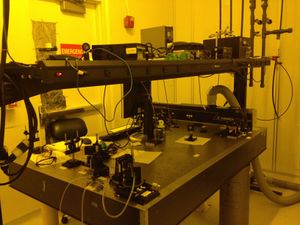Holographic Lith/PL Setup (Custom): Difference between revisions
mNo edit summary |
mNo edit summary |
||
| Line 18: | Line 18: | ||
A photoluminescence measurement setup is co-located on the optical table. Please see the page for the PL system for more info: |
A photoluminescence measurement setup is co-located on the optical table. Please see the page for the PL system for more info: |
||
*[[Photoluminescence PL Setup (Custom)]] |
*[[Photoluminescence PL Setup (Custom)|'''Photoluminescence PL Setup (Custom)''']] |
||
==Detailed Specifications== |
==Detailed Specifications== |
||
Revision as of 23:54, 5 February 2025
| ||||||||||||||||||||||||||||||
About
Holography Lithography
The interference lithography system (aka. Holography) at UCSB uses a 15mW, single-mode, 325 nm HeCd laser that is filtered and expanded by pinhole filters to produce the large area exposure beam. The system uses a simple mirror configuration with a fixed 90 degree angle between the mirror and sample. The entire mirror/sample assembly is rotated in 0.1 degree increments to change the grating pitch from ~ 200 nm to ~ 280 nm (35 to 55 degrees) over an ~ 2 cm x 2 cm exposure area.
XHRiC bottom anti-reflection coating (BARC) & THMR-3600HP imaging resist spin-coated to ~80 nm thickness is used for grating exposure. 2-D gratings can be formed by rotating the sample and doing multiple exposures. Total exposure times are controlled by a manual shutter and are generally several minutes in length.
Photoluminescence Measurement
A photoluminescence measurement setup is co-located on the optical table. Please see the page for the PL system for more info:
Detailed Specifications
- 15 mW single TEM mode HeCd laser (Kimmon)
- Max sample size: ~1.5 inch square uniform exposure area
- ~2 cm x 2 cm uniform exposure area
- Several-minute exposure times (manual shutter)
- Grating period adjustable from ~200 to ~280 nm with rotation stage
- Manual optics alignment.
- 1-D and 2-D gratings possible, see recipes below.
Recipes
- Lithography Recipes > Holography Recipes - developed recipes for 1D (line/space) and 2D (pillars) gratings.
